薩摩焼錦手に偶然出会いました(愛知県名古屋市千種区姫池通 骨董買取 古美術風光舎
2023.08.20
皆さまこんにちは。スタッフHでございます。
まだまだ秋は遠く、容赦ない太陽の光が照り付けていますね。
そんな中、私は急いで忘れ物を取りに帰るという失態をし、さらに体力を使い果たしております。
さて、帰省中台風に見舞われましたが、素敵な出会いもありました。
某デパートをうろうろしていると、煌びやかな焼き物が展示されているコーナーに出くわしました。
自由に観られるよう解放されていましたので拝見することにしました。
薩摩焼錦手と呼ばれる焼き物がルーペと共に並んでいました。
肉眼で見ることが難しいくらいの緻密なデザインが施され、人間の手で描かれたとは信じ難いものでした。
「写真は撮れないですよねぇ」とスタッフの方に恐る恐る尋ねると、「そうですねぇ…」と言葉を濁されたので、あきらめてゆっくり鑑賞させていただきました。
しばらくすると、後ろから「今なら写真を撮ってもいいですよ」と声をかけられました。「お客さんの中には写真を撮ることに不快感を感じる方がいるんですよね。今は誰もいないのでどうぞ」と。
振り向くと私以外、誰もいなくなっておりました。
スタッフの方に薩摩焼錦手についての説明を受けながら、写真を撮らせていただきました。
私の撮影技量でどこまで伝わるか疑問ですが、皆さまとこの繊細さを共有できれば幸いです。
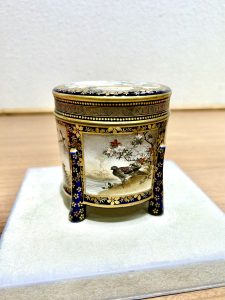
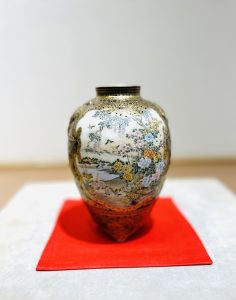
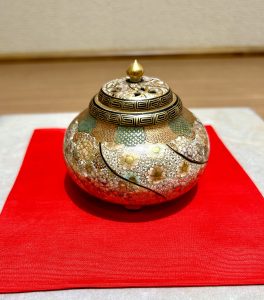
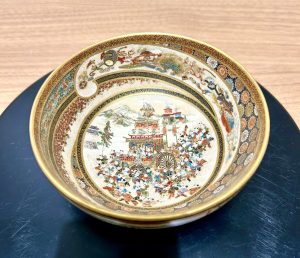
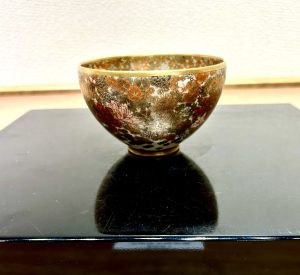
写真では分かりにくいのですが、花入れ以外はとても小さく手のひらサイズで、そこにこの精密さで描かれているのです。多様な色彩のため、焼成は最低でも4回は必要で、製作時間は膨大なものになるそうです。これらの品はヨーロッパから里帰りしたものだということ。
説明していただいた内容を整理させてくださいね。薩摩焼とは、朝鮮出兵(1592~1598)の際、島津義弘によって連れてこられた朝鮮陶工たちが薩摩各地に窯を開いたことに始まります。その中でも現在も窯場が残っているのは、「苗代川系」「竪野系」「龍門司系」の3つです。また薩摩焼は使われている土の材質から、「白もん」「黒もん」に大別されます。
陶工たちは故郷である朝鮮の地に思いを馳せながら、異国薩摩の地で白肌の美しい陶器、白薩摩をうみだしました。
鹿児島には鉄分を多く含む桜島の火山灰が降り注ぐため、白土は大変貴重なものであり、白もんは薩摩の御用品で、庶民は豊富に採れる黒褐色の土で作った黒もんを使用することが許されました。
そういえば、薩摩焼酎を飲む杯は黒いイメージがあります。
その後、幕末に目覚ましい変化が訪れます。1867年、薩摩藩はフランスの万博博覧会に薩摩焼を出品し高い評価を受け、国内産業であった薩摩焼は一転して外国への輸出品となりました。
日本的な絵付けを強調し、京都でも金襴手様式の薩摩焼を作成し始めます。これは「京薩摩」と称されました。
1873年のウィーン万博に出品した12代沈壽官の大花瓶が絶賛され、薩摩焼錦手は欧米では「SATSUMA」と呼ばれ世界中で広く認知されたとのことです。
司馬遼太郎の短編小説「故郷忘じがたく候」には沈壽官家の末裔の一人である14代沈壽官氏の半生が描かれているそうです。短編!ぜひ読んでみたいと思います。
それでは、またお会いしましょう。
Hello everyone. This is Staff H.
Autumn is still far away and the relentless sun is shining on us.
In the midst of it all, I made the mistake of rushing back home to pick up something I had forgotten, and I am running out of energy even more.
Well, I was hit by a typhoon while returning home, but I also had a wonderful encounter.
While wandering around a certain department store, I came across a corner where glittering pottery was on display.
It was open for free viewing, so I decided to take a look.
There was a line of pottery called “Satsuma Nishikite” with a loupe.
It was hard to believe that they were painted by human hands, as they were so intricately designed that it was difficult to see with the naked eye.
When I asked one of the staff members, “You can’t take pictures, can you?” he replied, “Well, I guess so…” I gave up and let him take his time.
After a while, I was approached from behind and told, “You can take a picture now. He said, “I know some of our customers feel uncomfortable about having their picture taken. There is no one here right now, so please go ahead.” I turned around and saw no one but me.
When I turned around, no one was there but me.
I was allowed to take pictures while the staff explained about Satsuma Nishikide to me.
I am not sure how much my photographic skills can convey, but I would be happy if I could share the delicacy with you.
It is hard to tell from the photos, but the pieces other than the flower vase are very small, the size of the palm of one’s hand, and painted with such precision. Because of the wide variety of colors, at least four firings are required, and the production time is said to be enormous. He said that these items were returned from Europe.
Let me summarize what I was explaining. Satsuma-yaki pottery dates back to the time when Korean potters brought by Shimazu Yoshihiro during the Korean invasion (1592-1598) opened kilns in various parts of Satsuma. Of these, three kilns still remain today: the Nayogawa, Tateno, and Ryumonji kilns. Satsuma-yaki is also broadly classified into “Shiro-mon” and “Kuro-mon” based on the material of the clay used.
The potters produced Shiro-satsuma, a beautiful white-skinned pottery in the foreign land of Satsuma, while thinking of their hometown in Korea.
Because Kagoshima is covered with volcanic ash from Sakurajima, which contains a lot of iron, white clay was very precious.
Come to think of it, the cup used to drink Satsuma shochu has a black image.
Then came a remarkable change at the end of the Edo period: in 1867, the Satsuma clan exhibited Satsuma-yaki at the Exposition Universelle in France, where it was highly acclaimed, and Satsuma-yaki, once a domestic industry, turned around and became an export product to foreign countries.
The domestic industry turned around and Satsuma-yaki was exported to foreign countries. This was called “Kyo Satsuma” (Kyoto Satsuma).
The large vase by the 12th generation Chinjukan exhibited at the Vienna Expo in 1873 was highly acclaimed, and Satsuma porcelain nishikite was widely recognized in the West as “SATSUMA” and throughout the world.
Ryotaro Shiba’s short story “Hometown Oblivious” describes the life of the 14th generation Chinjugan Shen, one of the descendants of the Chinjugan Shen family. Short story! I would love to read it.
Well, I will see you again.
*******************
ご実家の整理やお片付けなどをされている方のご相談などが多くございます。
お片付けなどくれぐれもご無理のないようになさってくださいませ。
風光舎では古美術品や骨董品の他にも絵画や宝石、趣味のお品など様々なジャンルのものを買受しております。
お片付けをされていて、こういうものでもいいのかしらと迷われているものでも、どうぞお気軽にご相談下さいませ。
また風光舎は、出張買取も強化しております。ご近所はもちろん、愛知県内、岐阜県、三重県その他の県へも出張いたします。
まずは、お電話お待ちしております。
愛知県名古屋市千種区姫池通
骨董 買取【古美術 風光舎 名古屋店】
TEL052(734)8444
10:00-17:00 OPEN
#出張買取#骨董#古美術#骨董品#絵画#版画#茶道具#刀剣#彫刻

